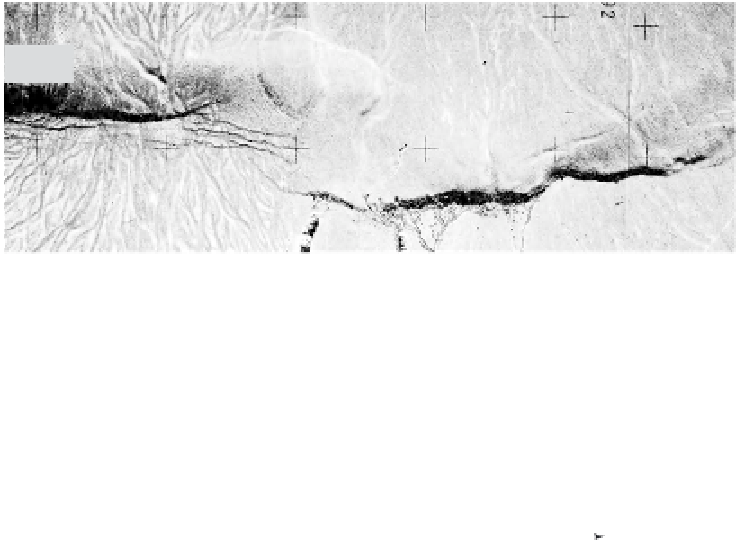Geology Reference
In-Depth Information
older
terrace
fold
axes
500 m
}
crestal
graben
1
damage
zone
Int
e
racting Thrust
Fault Tip Zone
2
North
A
15
displacement profile
of south fault
displacement profile
of north fault
summed fault
displacement
10
damage-zone
faults
5
1
2
B
0
16
summed fold
and fault
displacement
summed fault
displacement
12
8
displacement
from folding
4
0
0
500
1000
1500
2000
C
Distance along array (m)
Fig. 4.15
Interacting faults and folds, New Zealand.
Compensating faults and folds in the Ostler Fault zone, South Island, New Zealand. A. Two, non-overlapping thrust
faults (1, 2) cut a 20 kyr old outwash terrace. Between their tips, numerous small thrusts define a “damage zone.”
Active folding and a backthrust also accommodate shortening. B. Profiles of thrust-fault displacement for both large
faults, the backthrust, and damage-zone faults. Note that the slip deficit between faults 1 and 2 is partly filled by the
cumulative slip on the damage-zone faults and backthrust. C. When shortening due to fault-propagation folding is
added to the fault slip, the overall slip gradient becomes even smoother, indicating the importance of both folding
and faults in accommodating shortening.
overall profile near the overlapping tips of the
major faults, for example, between faults “b”
and “c”. Finally, these slip deficits can be filled
by slip and tilting accumulated on arrays of
smaller faults spanning the larger faults, as
is seen between faults “a” and “b”. One can
imagine that, with increasing displacement,
these faults may amalgamate into a single
irregular, but continuous, fault trace. At
present, however, based only on the summed
displacement profile alone, it would be difficult
to estimate how many faults contribute to
that profile.
Thus far we have largely used examples from
extensional settings to illustrate fault interac-
tions. Similar compensatory trade-offs in dis-
placement also occur in contractional settings.
For example, the Ostler Fault zone comprises
an elongate suite of active thrusts and fault-
related folds that extend for 70 km along the
eastern flank of the Southern Alps of New
Zealand (Read, 1984). Because these faults
deform young glacial outwash surfaces, a
remarkably clear record of recent deformation
is revealed by their displacement patterns
(Fig. 4.15). Here, the slip deficit between the






















































































































































































































































